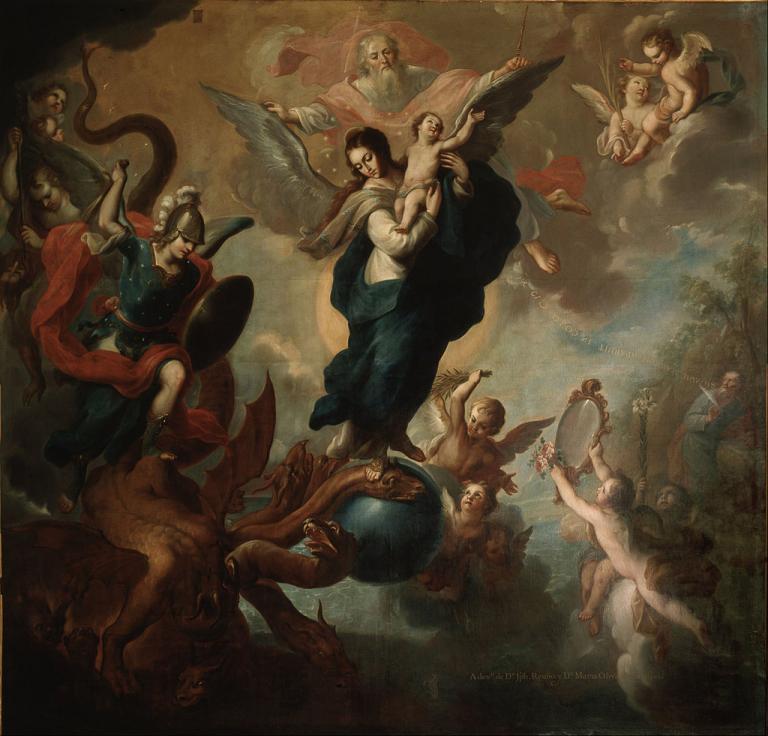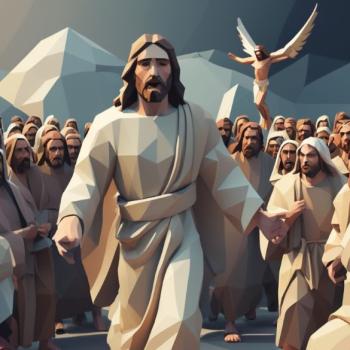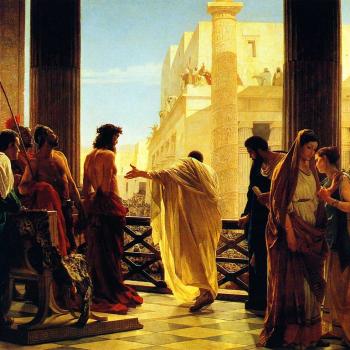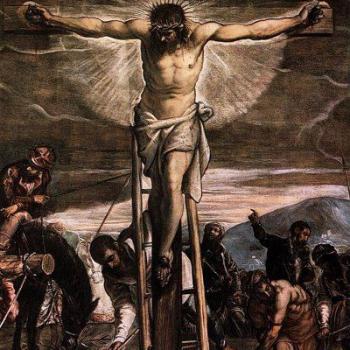What we know about the nativity of Jesus comes from the Gospels of Matthew and Luke. Mark starts his account of Christ with His baptism, and John goes back as far as possible for His origin: “ In the beginning was the Word, and the Word was with God, and the Word was God” (John 1:1). Then, like Mark, John jumps to John the Baptist.
But John does write about the Christ Child, not in his Gospel but in the Book of Revelation.
Like everything in that description of a vision, the account is enigmatic and mysterious. But it’s John’s Christmas story. And it’s also about us today:
And a great sign appeared in heaven: a woman clothed with the sun, with the moon under her feet, and on her head a crown of twelve stars. 2 She was pregnant and was crying out in birth pains and the agony of giving birth. 3 And another sign appeared in heaven: behold, a great red dragon, with seven heads and ten horns, and on his heads seven diadems. 4 His tail swept down a third of the stars of heaven and cast them to the earth. And the dragon stood before the woman who was about to give birth, so that when she bore her child he might devour it. 5 She gave birth to a male child, one who is to rule all the nations with a rod of iron, but her child was caught up to God and to his throne, 6 and the woman fled into the wilderness, where she has a place prepared by God, in which she is to be nourished for 1,260 days. (Rev. 12:1-6)
Most of the attention given to this passage has to do with the identity of the woman. We’ll discuss that controversy later. But most commentators agree that the child “who is to rule all the nations with a rod of iron” is Jesus.
This passage describes the great hatred that the dragon, explicitly identified as Satan, has for Christ. How he sought to kill the child, recalling his servant Herod and the slaughter of the innocents. All through the child’s life, Satan tried to “devour him,” until Christ’s Ascension. Whereupon this “dragon” is defeated and “thrown down.”
Even though Satan is defeated and thwarted, he continues to persecute the woman and “the rest of her offspring”; namely, us Christians:
7 Now war arose in heaven, Michael and his angels fighting against the dragon. And the dragon and his angels fought back, 8 but he was defeated, and there was no longer any place for them in heaven. 9 And the great dragon was thrown down, that ancient serpent, who is called the devil and Satan, the deceiver of the whole world—he was thrown down to the earth, and his angels were thrown down with him. . . .
13 And when the dragon saw that he had been thrown down to the earth, he pursued the woman who had given birth to the male child. 14 But the woman was given the two wings of the great eagle so that she might fly from the serpent into the wilderness, to the place where she is to be nourished for a time, and times, and half a time. 15 The serpent poured water like a river out of his mouth after the woman, to sweep her away with a flood. 16 But the earth came to the help of the woman, and the earth opened its mouth and swallowed the river that the dragon had poured from his mouth. 17 Then the dragon became furious with the woman and went off to make war on the rest of her offspring, on those who keep the commandments of God and hold to the testimony of Jesus. (Rev. 7-9; 13-17)
So who is the woman who gives birth to the child? The Virgin Mary? Catholics certainly think so. They see in the “woman clothed with the sun, with the moon under her feet, and on her head a crown of twelve stars” the Queen of Heaven, whom they portray in their iconography as standing on the crescent moon with stars in her hair. (I had heard that the medieval depictions of Mary with the moon under her feet derive from depictions of the pagan moon-goddess Diana, which is evidence that the veneration of the Virgin Mary is simply a displacement of early European goddess-worship. But the imagery clearly derives instead from this passage.)
And yet, this passage does not completely accord with Catholic Mariology. This woman “was crying out in birth pains and the agony of giving birth.” Catholics believe that Mary had an “immaculate conception,” so that she was born without original sin. That means that she was not under the curse of Eve, which included “pain in childbearing” (Gen 3:16). Thus, Catholic piety insists that she experienced no pain in giving birth to Jesus.
A Protestant reading could also allow for the woman to be the Virgin Mary. We know that Jesus on the Cross entrusted His mother to John’s care (John 19:17). Revelation is said to have been written by John when he was at an advanced age. By then, Mary would have died–or, as Catholics believe, ascended into Heaven, since her lack of original sin meant that she was not under the sentence of death–and John would have surely thought of her as being in Heaven.
Yet the passage goes on to describe the dragon’s persecution of the woman in extended and elaborate conflicts. We don’t know how Satan might have tormented Mary after her Son’s Ascension, but what Revelation describes here sounds more universal. The dragon is also making war “on the rest of her offspring,” clearly identified as “those who keep the commandments of God and hold to the testimony of Jesus”; that is on Christians. I’m not sure that even Catholics would consider Christians to be “offspring” of Mary.
This leads to other interpretations of the woman’s identity. Some say she represents the Church. But the Book of Revelation depicts the Church as Christ’s bride, not His mother. And surely the Church doesn’t bring forth Christ; rather, He brings forth the Church. Others interpret the woman as Israel. Certainly, Satan has persecuted the Jews since Christ’s ascension, but, as a group, they have not been in league with Jesus.
The Lutheran Study Bible probably gives the best answer in saying that she represents “God’s People,” both in the Old Testament and in the age of the Church. The Jews did give birth to Christ, and the Church was being severely persecuted at the time of John’s vision and thereafter, including today. Then again, as Al Collver of the LCMS points out, the Virgin Mary is a type of the Church, the New Israel, so perhaps the symbols all come together.
At any rate, the message of Christmas is unambiguously given in John’s account:
10 And I heard a loud voice in heaven, saying, “Now the salvation and the power and the kingdom of our God and the authority of his Christ have come, for the accuser of our brothers[b] has been thrown down, who accuses them day and night before our God. 11 And they have conquered him by the blood of the Lamb and by the word of their testimony, for they loved not their lives even unto death. 12 Therefore, rejoice, O heavens and you who dwell in them! (Rev 12:10-12)
(This post revisits a topic from 10 years ago.)
Image: “The Virgin of the Apocalypse,” by Miguel Cabrera (1790), Public domain, via Wikimedia Commons


















